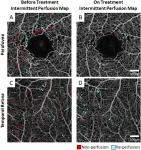(Press-News.org) Only one in three fertilizations leads to a successful pregnancy. Many embryos fail to progress beyond early development. Cell biologists at the Max Planck Institute (MPI) for Biophysical Chemistry in Göttingen (Germany), together with researchers at the Institute of Farm Animal Genetics in Mariensee and other international colleagues, have now developed a new model system for studying early embryonic development. With the help of this system, they discovered that errors often occur when the genetic material from each parent combines immediately after fertilization. This is due to a remarkably inefficient process.
Human somatic cells typically have 46 chromosomes, which together carry the genetic information. These chromosomes are first brought together at fertilization, 23 from the father's sperm, and 23 from the mother's egg. After fertilization, the parental chromosomes initially exist in two separate compartments, known as pronuclei. These pronuclei slowly move towards each other until they come into contact. The pronuclear envelopes then dissolve, and the parental chromosomes unite.
The majority of human embryos, however, end up with an incorrect number of chromosomes. These embryos are often not viable, making erroneous genome unification a leading cause of miscarriage and infertility.
"About 10 to 20 percent of embryos that have an incorrect number of chromosomes result from the egg already containing too few or too many chromosomes prior to fertilization. This we already knew," explains Melina Schuh, director at the MPI for Biophysical Chemistry. "But how does this problem arise in so many more embryos? The time immediately after the sperm and egg unite - the so-called zygote stage - seemed to be an extremely critical phase for the embryo's development. We wanted to find out why this is the case."
Insights from a new model system
For their investigations, the scientists analyzed microscopy videos of human zygotes that had been recorded by a laboratory in England. They additionally set out to find a new model organism suitable for studying early embryonic development in detail. "Together with our collaboration partners at the Institute of Farm Animal Genetics, we developed methods for studying live bovine embryos, which closely resemble human embryos," explains Tommaso Cavazza, a scientist in Schuh's department. "The timing of the first cell divisions is comparable in human and bovine embryos. Furthermore, the frequency of chromosomes distributing incorrectly is about the same in both systems." Another advantage of this model system is: The scientists obtained the eggs from which the bovine embryos developed from slaughterhouse waste, so no additional animals had to be sacrificed.
Schuh's team fertilized the bovine eggs in vitro and then used live-cell microscopy to track how the parental genetic material unites. They found that the parental chromosomes cluster at the interface between the two pronuclei. In some zygotes, however, the researchers noticed that individual chromosomes failed to do so. As a result, these chromosomes were 'lost' when the parental genomes united, leaving the resulting nuclei with too few chromosomes. These zygotes soon showed developmental defects.
"The clustering of chromosomes at the pronuclear interface seems to be an extremely important step," Cavazza explains. "If clustering fails, the zygotes often make errors that are incompatible with healthy embryo development."
Dependent on an inefficient process
But why do parental chromosomes often fail to cluster correctly? The Max Planck researchers were able to uncover that as well, as Cavazza reports: "Components of the cytoskeleton and the nuclear envelope control chromosome movement within the pronuclei. Intriguingly, these elements also steer the two pronuclei towards each other. So we are dealing with two closely linked processes that are essential, but often go wrong. Thus, whether an embryo will develop healthily or not depends on a remarkably inefficient process."
The scientists' findings are also relevant for in vitro fertilization in humans. It has been discussed for some time whether the accumulation of the so-called nucleoli at the pronuclear interface in human zygotes could be used as an indicator for the chance of successful fertilization. Zygotes in which these pronuclear components all cluster at the interface have a better chance of developing successfully, and could therefore be preferentially used for fertility treatment. "Our observation that chromosomes need to cluster at the interface to guarantee healthy embryo development supports this selection criterion," Schuh says.
INFORMATION:
Original publication
Cavazza T, Takeda Y, Politi AZ, Aushev M, Aldag P, Baker C, Choudhary M, Bucevičius J, Lukinavičius G, Elder K, Blayney M, Lucas-Hahn A, Niemann H, Herbert M, Schuh M.
Parental genome unification is highly error-prone in mammalian embryos.
Cell (2021) May 7, 2021
Ophthalmologists at New York Eye and Ear Infirmary of Mount Sinai have created a new technique to evaluate patients with sickle cell retinopathy and assess the disease before it progresses and leads to permanent vision loss.
Using optical coherence tomography (OCT) angiography--an advanced imaging system that captures the motion of red blood cells in blood vessels non-invasively--the researchers discovered that sequential imaging of affected retinal blood flow in sickle cell patients can help assess how the disease is progressing and how effective their treatment is for reducing focal vascular strokes. Their study was published ...
Porcupines are frequently traded across Asia, and Indonesia, home to five species, is no exception. They are targeted for a number of reasons: their meat as an alternative source of protein, their bezoars consumed as traditional medicine, and their quills used as talismans and for decorative purposes.
A new study examining seizure data of porcupines, their parts and derivatives in Indonesia found a total of 39 incidents from January 2013 to June 2020 involving an estimated 452 porcupines. The research was published in the open-access, peer-reviewed journal Nature Conservation.
There are no harvest quotas for any porcupine species in Indonesia, which makes all hunting and trade in porcupines illegal. Of the five species found in the country, only the Sunda porcupine (Hystrix javanica) ...
COLUMBUS, Ohio - The symptoms of grief people feel for a loved one facing a life-limiting illness fluctuate over time, a new study found - suggesting that individuals can adjust to their emotional pain, but also revealing factors that can make pre-loss grief more severe.
Researchers examined changes in the severity of pre-loss grief symptoms in people whose family members had either advanced cancer or dementia.
The study is the first to document pre-loss grief at two points in time, and found that about 70% of participants' symptoms decreased over a month. However, compared to initial symptoms reported by participants, ...
An analysis of historical medical records found that men who were prenatally exposed during early gestation to the Dutch famine of 1944-1945 were 30 percent more likely to be overweight with a Body Mass Index of 25 or over at age 19, compared to a similar group not exposed to the famine. Professor L. H. Lumey at Columbia University Mailman School of Public Health led the study, which is published in the International Journal of Obesity. The study confirms evidence on the health risks of prenatal famine exposure, which also includes diabetes and schizophrenia.
The mechanism by which famine exposure raises the risk for later excess weight is still unknown. The researchers speculate that famine exposure could lead to changes in DNA methylation that stimulate being overweight. Or that surviving ...
MRSA skin infections are often treated with intravenous injection of antibiotics, which can cause significant side effects and promote the development of resistant bacterial strains. To solve these problems, researchers at Karolinska Institutet in Sweden are developing a microneedle patch that delivers antibiotics directly into the affected skin area. New results published in Advanced Materials Technologies show that the microneedle patch effectively reduces MRSA bacteria in the skin.
MRSA (methicillin resistant Staphylococcus aureus) skin infections are potentially lethal, ...
A new approach to tackling viruses by targeting the 'control centre' in viral RNA could lead to broad spectrum anti-viral drugs and provide a first line of defence against future pandemics, according to new research at the University of Birmingham.
In a new study, published in Angewandte Chemie, researchers have shown how this approach could be effective against the SARS-CoV-2 virus responsible for the COVID-19 pandemic. Earlier modelling and in vitro analysis by the team and published in Chemical Science has also shown effectiveness against the HIV virus.
Professor Mike Hannon, from the University of Birmingham's School of Chemistry, is co-lead author ...
Captive pelicans that are free to choose their own friendships are more likely to breed successfully on repeated occasions, new research suggests.
Social network analysis on captive great white pelicans, led by the University of Exeter, found that providing social choice within the flock and allowing partnerships to form naturally led to improved breeding success.
The study revealed that the pelicans chose their specific social relationships, and that there was a social structure across the flock, in which sub-adults (the equivalent of teenagers) spent more time with each other than with adult birds.
Zoo-housed pelicans are common, but their breeding record is poor and they receive little ...
FRANKFURT. The virostatic agent remdesivir was developed to disrupt an important step in the propagation of RNA viruses, to which SARS-CoV-2 also belongs: the reproduction of the virus's own genetic material. This is present as RNA matrices with which the host cell directly produces virus proteins. To accelerate the production of its own proteins, however, RNA viruses cause the RNA matrices to be copied. To do so, they use a specific protein of their own (an RNA polymerase), which is blocked by remdesivir. Strictly speaking, remdesivir does not do this itself, but rather a substance that is synthesized from remdesivir in five steps when remdesivir penetrates a cell.
In ...
A new Dartmouth-led study, published this week in the journal Pediatrics, has found that the disproportionate use of premiums within child-targeted TV advertising for children's fast-food meals is deceptive. The researchers examined thousands of advertisements from 11 fast-food restaurants, but one company--McDonald's--accounted for nearly all the airtime and, as a result, the findings.
The researchers report that these ads often overemphasize premiums such as toy giveaways and games relative to the primary product being sold, the fast food itself. This marketing practice violates the industry's own guidelines--put in place to ensure that the use of premiums in ads is not deceptive or unfair--as young children lack the cognitive ability ...
Announcing a new article publication for BIO Integration journal. In this review the authors Yuheng Bao, Jifan Chen, Pintong Huang and Weijun Tong from Zhejiang University, Hangzhou, China discuss the synergistic effects of acoustics-based therapy and immunotherapy in cancer treatment.
Cancer immunotherapy to enhance the autogenous immune response to cancer tissue is reported to be a promising method for cancer treatment. After the release of damage-associated molecular patterns, dendritic cells mature and recruit activated T cells to induce immune response.
To trigger the release of cancer associated antigens, cancer acoustics-based therapy has various prominent advantages and has been reported in various research. ...



